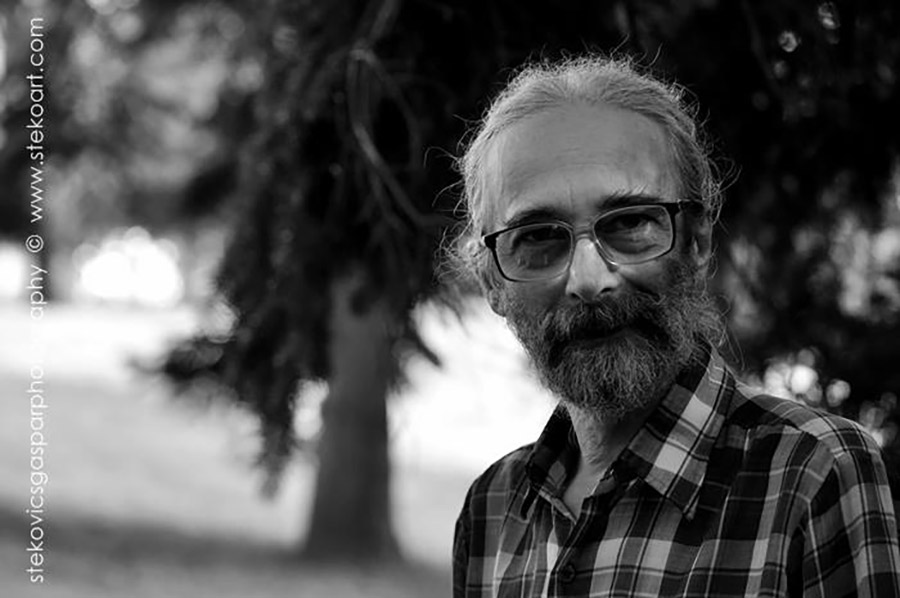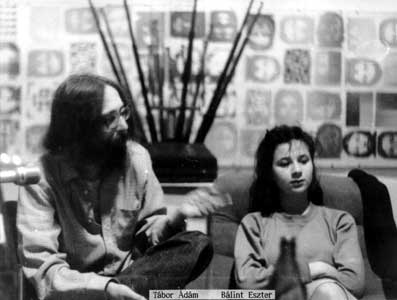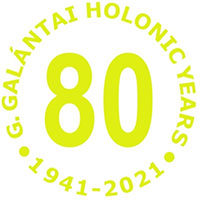Ádám Tábor (H)
Greetings to the chapel artist – Galántai 80
Galántai György több mint fél évszázada harcol – elszántan, de a lehető legbékésebben – az avantgárd kultúra szabadságáért és egy világi és egyházi birodalmakkal szembeni szabad művészeti ellen-birodalom, globális szellemi-művészi kapcsolatháló megteremtéséért.
A ma 80 éves Galántai Györgyöt köszönti Tábor Ádám.
I have known, loved and respected György Galántai from the very start as an independent and inventive man with a sense of solidarity who is able to continually renew himself as an Avant-garde artist, while being an exceptional animator and organiser of the Hungarian and international Neo-Avant-garde art movement. For me the start was the summer of 1972, i.e. my – passive – participation in the DIRECT WEEK held as part of the third summer season of the Balatonboglár Chapel Studio. In 1973 I already went over there three times to see the exhibitions and the King Kong performance of the Kassák Theatre. Then we would often meet and talk in the Young Artists’ Club at exhibition openings etc.
A really intensive, frequent and close friendship and professional relationship formed between us when Artpool was founded, at Galántai’s and Júlia Klaniczay’s flat on the Frankel Leo Road.
From 1979 I would often trundle up to the top floor, where their studio was set up, to exchange ideas and information and to peep into the first dossiers of the Artpool archive and later to collect the new issues of the samizdat Avant-garde art-counter culture periodical titled AL (Artpool Letter - Topical Letter), launched in 1983. This publication was fully conceived, laid out and printed by him, and he regarded it, along with the entire Artpool, not only as an archive or a counter-museum but also as a work of art. The Galántais went to every underground cultural event and made audio and visual recordings of them. Many of these – or details of them – were published in the Artpool Letter; this is how Miklós Erdély's Mineral Wool and how my poems and theses recited at the evening of the live periodical titled Lélegzet [Breath] were included there.They also reported about the marathon reading of one of the volumes of Béla Hamvas’ Carnival, also put on by Lélegzet and accompanied by simultaneous art reactions. They themselves organised in-depth discussions in their studio, for example with István Bálint and László Rajk about the Kassák Theatre-Apartment-Theatre-Squat, which was also printed in their periodical.
I debuted in AL in issue 5 in the summer of 1983 with my piece Iconoclasm – Centaur. I had written this short analysis in autumn-winter 1975 based on my notes taken after the exclusive first screening of Tamás Szentjóby’s film, upon the director’s express request in order to prevent the confiscation of the work. In the 1980s I was allowed again to publish my poems and critiques in the state media, yet reading this manuscript of mine in print brought on such a revelation and ecstasy in me – to my own absolute surprise – as if it had been my first ever publication. Indeed, it was the first one in media free from censorship.
I call György Galántai a chapel artist neither just because of his chapel studio and the chapel exhibitions in Balatonboglár,
nor because of any religious affiliations he might have, since I have no idea if he has any. Based on our conversations, his works and interviews I did not see any trace of it but that is his personal, sensitive affair.
The chapel is of course a religious/ecclesiastical concept: “a relatively small, church-like building or annex for worship”. The word is derived from the Latin word capella, cappa, which also means “a cape covering the head”. “According to tradition, Saint Martin of Tours, when still a soldier, gave a beggar” – who was “Jesus Christ in disguise”–“half of his cloak […] He wore the other half over his shoulder; that was the “small cape”, i.e. capella in Latin. The half-cloak was preserved as a relic by the Merovingian kings in their palaces and they “took it on their military campaigns.” Both the place in the palace where this relic was preserved and “the tent where the cloak was kept were called a capella”. This is the origin of the word chapel (Wikipedia).
György Galántai has been fighting for more than half a century – with determination but with as peaceful means as possible – for the freedom of Avant-garde culture and for the establishment, expansion and preservation of a free counter-empire of art – a global intellectual and art network – which defines itself against secular and ecclesiastical empires.
He has been building a tent=capella for a fortressless (©St. Auby Tamás) culture in his whole life: with his Chapel Hill in Balatonboglár as an artist, with AL in his flat and now with Artpool as the father of a public institution.
In the meantime, he has been wearing this tent as a half-cape=capella over his shoulder. On his 80th birthday I wish György Galántai – a secular chapel artist defying secular/ecclesiastical powers – to wear this capella for many years to come, together with his companion in all things, Júlia Klaniczay.

● Mirror ● International Hungary ● exindex ● worldcat ●


